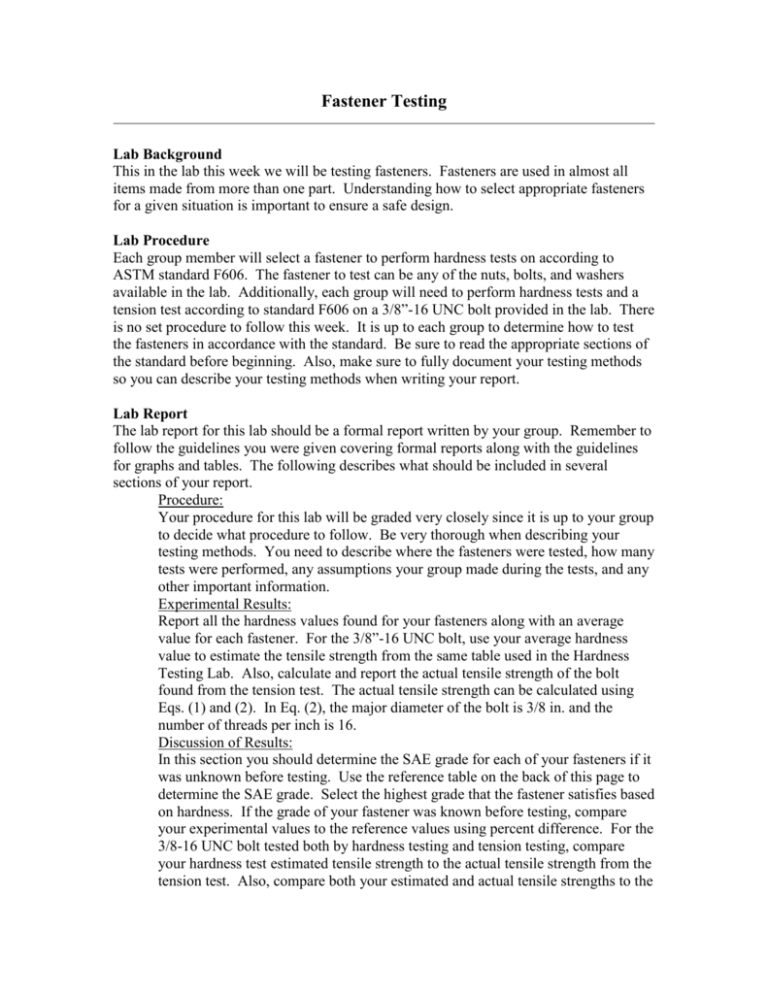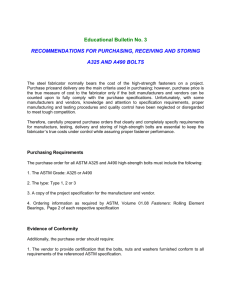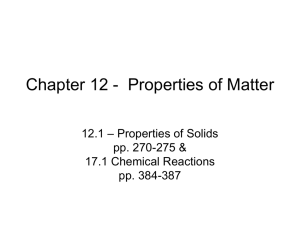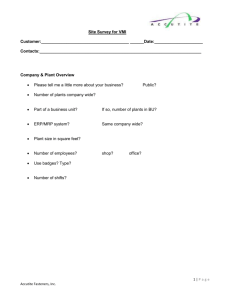handout
advertisement

Fastener Testing Lab Background This in the lab this week we will be testing fasteners. Fasteners are used in almost all items made from more than one part. Understanding how to select appropriate fasteners for a given situation is important to ensure a safe design. Lab Procedure Each group member will select a fastener to perform hardness tests on according to ASTM standard F606. The fastener to test can be any of the nuts, bolts, and washers available in the lab. Additionally, each group will need to perform hardness tests and a tension test according to standard F606 on a 3/8”-16 UNC bolt provided in the lab. There is no set procedure to follow this week. It is up to each group to determine how to test the fasteners in accordance with the standard. Be sure to read the appropriate sections of the standard before beginning. Also, make sure to fully document your testing methods so you can describe your testing methods when writing your report. Lab Report The lab report for this lab should be a formal report written by your group. Remember to follow the guidelines you were given covering formal reports along with the guidelines for graphs and tables. The following describes what should be included in several sections of your report. Procedure: Your procedure for this lab will be graded very closely since it is up to your group to decide what procedure to follow. Be very thorough when describing your testing methods. You need to describe where the fasteners were tested, how many tests were performed, any assumptions your group made during the tests, and any other important information. Experimental Results: Report all the hardness values found for your fasteners along with an average value for each fastener. For the 3/8”-16 UNC bolt, use your average hardness value to estimate the tensile strength from the same table used in the Hardness Testing Lab. Also, calculate and report the actual tensile strength of the bolt found from the tension test. The actual tensile strength can be calculated using Eqs. (1) and (2). In Eq. (2), the major diameter of the bolt is 3/8 in. and the number of threads per inch is 16. Discussion of Results: In this section you should determine the SAE grade for each of your fasteners if it was unknown before testing. Use the reference table on the back of this page to determine the SAE grade. Select the highest grade that the fastener satisfies based on hardness. If the grade of your fastener was known before testing, compare your experimental values to the reference values using percent difference. For the 3/8-16 UNC bolt tested both by hardness testing and tension testing, compare your hardness test estimated tensile strength to the actual tensile strength from the tension test. Also, compare both your estimated and actual tensile strengths to the minimum value given in the reference table. Finally, compare all your fasteners based on hardness and discuss if the results match what was expected prior to testing. Conclusions: You should mention any difficulty you had while following the ASTM standard in your conclusion. Also, discuss any changes you would make to your testing procedure if you were to repeat the tests. Presentation Each group will come to the board and write their experimental values for the following: Fastener Avg. Hardness SAE Grade Description Then, two random groups will be selected to answer the following questions: 1) How well did the estimated tensile strength based on your hardness test compare to the actual tensile strength for the group bolt? Explain any differences. 2) What is one application where you would choose to use SAE grade 2 fasteners? How could the low strength of grade 2 fasteners actually be a desirable feature? Equations (1) Bolt Tensile Strength: (2) Thread Stress Area: F Sut As Sut= tensile strength, psi F = load, lb As = thread stress area, in2 0.9743 As 0.7854 D N As= thread stress area, in2 D= major diameter, in N= threads per inch, tpi 2 Reference Values Minimum Hardness Tensile Minimum Maximum Strength (ksi) 1 0.25 – 1.5 60 70 HRB 100 HRB 2 0.25 - 0.75 74 80 HRB 100 HRB 5 0.25 - 1 120 25 HRC 34 HRC 8 0.25 – 1.5 150 33 HRC 39 HRC (Source: www.zerofast.com/markings.htm) Note: ASTM A307 bolts have the same required properties as SAE Grade 1 SAE Grade Diameter (in)



